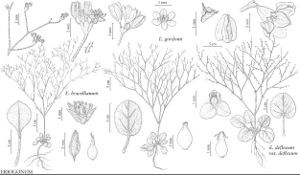Difference between revisions of "Eriogonum howellianum"
Phytologia 25: 204. 1973.
FNA>Volume Importer |
FNA>Volume Importer |
||
| Line 24: | Line 24: | ||
|elevation=(700-)1200-2100 m | |elevation=(700-)1200-2100 m | ||
|distribution=Nev.;Utah. | |distribution=Nev.;Utah. | ||
| − | |discussion=<p>Eriogonum howellianum is encountered infrequently in widely scattered locations in southern Nevada (Clark, Lincoln, Nye, and White Pine counties) and west-central Utah (Juab, Millard, and Tooele counties). A disjunct population occurs on Pilot Peak in extreme eastern Elko County, Nevada. This species is rarely common. The name E. glandulosum was long misapplied to these plants.</p> | + | |discussion=<p><i>Eriogonum howellianum</i> is encountered infrequently in widely scattered locations in southern <i>Nevada</i> (Clark, Lincoln, Nye, and White Pine counties) and west-central Utah (Juab, Millard, and Tooele counties). A disjunct population occurs on Pilot Peak in extreme eastern Elko County, <i>Nevada</i>. This species is rarely common. The name <i>E. glandulosum</i> was long misapplied to these plants.</p> |
|tables= | |tables= | ||
|references= | |references= | ||
| Line 48: | Line 48: | ||
|publication year=1973 | |publication year=1973 | ||
|special status= | |special status= | ||
| − | |source xml=https://jpend@bitbucket.org/aafc-mbb/fna-data-curation.git/src/ | + | |source xml=https://jpend@bitbucket.org/aafc-mbb/fna-data-curation.git/src/8f726806613d60c220dc4493de13607dd3150896/coarse_grained_fna_xml/V5/V5_794.xml |
|subfamily=Polygonaceae subfam. Eriogonoideae | |subfamily=Polygonaceae subfam. Eriogonoideae | ||
|genus=Eriogonum | |genus=Eriogonum | ||
Revision as of 17:41, 18 September 2019
Herbs, erect to spreading, annual, 0.5–3 dm, glandular, greenish or reddish green. Stems: caudex absent; aerial flowering stems erect, solid, not fistulose, 0.3–1 dm, glandular. Leaves basal; petiole 0.5–4 cm, glabrous or sparsely pilose; blade broadly elliptic to oval, 0.7–2.5 × 0.7–2.5 cm, pilose-hirsutulous, rarely slightly glandular and green on both surfaces, margins entire. Inflorescences cymose, open, spreading, 5–25 × 5–35 cm; branches not fistulose, glandular; bracts 3, scalelike, 1–2 × 0.5–1.5(–2) mm. Peduncles absent or ascending to erect, straight or curved, slender, 0.2–0.5 cm at proximal nodes, 0.01–0.1 cm distally, proximal 1/2 sparsely glandular. Involucres turbinate-campanulate, 1.3–2 × 1–2 mm, glabrous; teeth (4–)5, erect, 0.5–0.8 mm. Flowers 1–1.5(–2) mm; perianth yellow with reddish midribs to entirely reddish, densely pilose; tepals monomorphic, lanceolate; stamens exserted, 1–1.5 mm; filaments glabrous. Achenes dull brown, 3-gonous, 1.5–1.8 mm, glabrous.
Phenology: Flowering Jun–Sep.
Habitat: Sandy to gravelly, often volcanic slopes, saltbush, greasewood, and sagebrush communities, pinyon-juniper woodlands
Elevation: (700-)1200-2100 m
Discussion
Eriogonum howellianum is encountered infrequently in widely scattered locations in southern Nevada (Clark, Lincoln, Nye, and White Pine counties) and west-central Utah (Juab, Millard, and Tooele counties). A disjunct population occurs on Pilot Peak in extreme eastern Elko County, Nevada. This species is rarely common. The name E. glandulosum was long misapplied to these plants.
Selected References
None.

